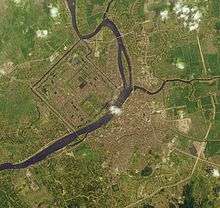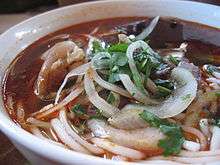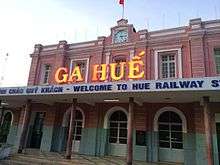Huế
| Huế Thành Phố Huế | |
|---|---|
| Provincial city (Class-1) | |
| Nickname(s): City of Romance, Festival City | |
 Huế Location of Huế | |
| Coordinates: 16°28′00″N 107°34′45″E / 16.46667°N 107.57917°E | |
| Country |
|
| Province | Thừa Thiên–Huế |
| Area | |
| • Total | 70.67 km2 (27.29 sq mi) |
| Elevation | 15 m (49 ft) |
| Population (2015) | |
| • Total | 354,124 |
| • Density | 5,010.9/km2 (12,978/sq mi) |
| Climate | Am |
| Website | huecity.gov.vn |
Huế (Vietnamese: [hwě] (![]()
History
Huế originally rose to prominence as the capital of the Nguyễn lords, a feudal dynasty that dominated much of southern Vietnam from the 17th to the 19th century. In 1775 when Trịnh lord Trịnh Sâm captured it, it was known as Phú Xuân (富春). The city's current name is likely a non-Sino-Vietnamese reading of the Chinese 化 (Sino-Vietnamese: hoá), as in the historical name Thuận Hoá (順化).

In 1802, Nguyễn Phúc Ánh (later Emperor Gia Long) succeeded in establishing his control over the whole of Vietnam, thereby making Huế the national capital.[1]
Minh Mạng (r. 1820-40) was the second emperor of the Nguyễn Dynasty, reigning from 14 February 1820 (his 29th birthday) until his death, on 20 January 1841. He was a younger son of Emperor Gia Long, whose eldest son, Crown Prince Cảnh, had died in 1801. Minh Mạng was well known for his opposition to French involvement in Vietnam, and for his rigid Confucian orthodoxy.
During the French colonial period, Huế was in the protectorate of Annam. It remained the seat of the Imperial Palace until 1945, when Emperor Bảo Đại abdicated and the DRV government was established with its capital at Hà Nội (Hanoi), in the north.[2]
While Bảo Đại was proclaimed "Head of the State of Vietnam" with the help of the returning French colonialists in 1949 (although not with recognition from the communists or the full acceptance of the Vietnamese people), his new capital was Sài Gòn (Saigon), in the south.[3]
During the Republic of Vietnam, Huế, being very near the border between the North and South, was vulnerable in the Vietnam War. In the Tết Offensive of 1968, during the Battle of Huế, the city suffered considerable damage not only to its physical features, but its reputation as well, due to a combination of the American military bombing of historic buildings held by the North Vietnamese, and the massacre at Huế committed by the communist forces.
After the war's conclusion, many of the historic features of Huế were neglected because they were seen by the victorious communist regime and some other Vietnamese as "relics from the feudal regime"; the Vietnamese Communist Party doctrine officially described the Nguyễn Dynasty as "feudal" and "reactionary." There has since been a change of policy, however, and many historical areas of the city are currently being restored.

Geography
The city is located in central Vietnam on the banks of the Perfume River, just a few miles inland from the East Sea. It is about 700 km (430 mi) south of Hanoi and about 1,100 km (680 mi) north of Hồ Chí Minh City.
Climate
Huế features a tropical monsoon climate under the Köppen climate classification. Failling short of a tropical rainforest climate. The dry season is from March to August, with high temperatures of 35 to 40 °C (95 to 104 °F). The rainy season is from August to January, with a flood season from October, onwards. The average rainy season temperature is 20 °C (68 °F), sometimes as low as 9 °C (48 °F). Spring lasts from January to late February.[4]
| Climate data for Huế | |||||||||||||
|---|---|---|---|---|---|---|---|---|---|---|---|---|---|
| Month | Jan | Feb | Mar | Apr | May | Jun | Jul | Aug | Sep | Oct | Nov | Dec | Year |
| Record high °C (°F) | 33.6 (92.5) |
36.3 (97.3) |
38.6 (101.5) |
39.9 (103.8) |
41.3 (106.3) |
40.7 (105.3) |
39.6 (103.3) |
39.7 (103.5) |
39.7 (103.5) |
36.1 (97) |
38.8 (101.8) |
32.2 (90) |
41.3 (106.3) |
| Average high °C (°F) | 23.8 (74.8) |
24.4 (75.9) |
27.7 (81.9) |
31.0 (87.8) |
33.3 (91.9) |
34.4 (93.9) |
34.7 (94.5) |
34.3 (93.7) |
31.5 (88.7) |
28.8 (83.8) |
26.1 (79) |
23.6 (74.5) |
29.5 (85.1) |
| Daily mean °C (°F) | 20.0 (68) |
20.7 (69.3) |
23.1 (73.6) |
26.1 (79) |
28.2 (82.8) |
29.3 (84.7) |
29.5 (85.1) |
29.0 (84.2) |
27.2 (81) |
25.3 (77.5) |
23.1 (73.6) |
20.7 (69.3) |
25.2 (77.4) |
| Average low °C (°F) | 17.6 (63.7) |
18.2 (64.8) |
20.3 (68.5) |
22.8 (73) |
24.4 (75.9) |
25.3 (77.5) |
25.2 (77.4) |
25.1 (77.2) |
24.1 (75.4) |
22.7 (72.9) |
20.8 (69.4) |
18.4 (65.1) |
22.1 (71.8) |
| Record low °C (°F) | 8.8 (47.8) |
11.0 (51.8) |
10.7 (51.3) |
14.1 (57.4) |
17.7 (63.9) |
20.9 (69.6) |
19.8 (67.6) |
21.0 (69.8) |
19.1 (66.4) |
15.9 (60.6) |
12.9 (55.2) |
9.5 (49.1) |
8.8 (47.8) |
| Average precipitation mm (inches) | 126 (4.96) |
65 (2.56) |
43 (1.69) |
58 (2.28) |
102 (4.02) |
113 (4.45) |
92 (3.62) |
117 (4.61) |
394 (15.51) |
757 (29.8) |
621 (24.45) |
311 (12.24) |
2,798 (110.16) |
| Average precipitation days | 14.4 | 11.9 | 10.3 | 10.7 | 13.0 | 10.3 | 8.2 | 11.0 | 16.6 | 20.8 | 21.5 | 19.7 | 168.2 |
| Average relative humidity (%) | 89.0 | 89.4 | 86.9 | 83.8 | 78.9 | 74.6 | 72.9 | 74.9 | 83.2 | 87.4 | 88.8 | 89.2 | 83.2 |
| Mean monthly sunshine hours | 114 | 110 | 147 | 177 | 234 | 231 | 247 | 218 | 173 | 136 | 100 | 85 | 1,970 |
| Source: Vietnam Institute for Building Science and Technology[5] | |||||||||||||
Government
.jpg)
Administrative divisions
Huế comprises 27 administrative divisions, including 27 phường (urban wards):
- An Cựu
- An Đông
- An Hoà
- An Tây
- Hương Sơ
- Kim Long
- Phú Bình
- Phú Cát
- Phú Hậu
- Phú Hiệp
- Phú Hòa
- Phú Hội
- Phú Nhuận
- Phú Thuận
- Phước Vĩnh
- Phường Đúc
- Tây Lộc
- Thuận Hòa
- Thuận Lộc
- Thuận Thành
- Trường An
- Vĩnh Ninh
- Vỹ Dạ
- Xuân Phú
- Hương Long
- Thủy Xuân
- Thủy Biều
Culture
In the center of Vietnam, Huế was the capital city of Vietnam for approximately 150 years during feudal times (1802–1945),[6] and the royal lifestyle and customs have had a significant impact on the characteristics of the people of Huế. That impact can still be felt today.
Name-giving
Historically, the qualities valued by the royal family were reflected in its name-giving customs, which came to be adopted by society at large. As a rule, royal family members were named after a poem written by Minh Mạng, the second emperor of Nguyễn Dynasty. The poem, Đế hệ thi",[7] has been set as a standard frame to name every generation of the royal family, through which people can know the family order as well as the relationship between royal members. More importantly, the names reflect the essential personality traits that the royal regime would like their offspring to uphold. This name-giving tradition is proudly kept alive and nowadays people from Huế royal family branches (normally considered 'pure' Huế) still have their names taken from the words in the poem.
Clothing
The design of the modern-day áo dài, a Vietnamese national costume, evolved from an outfit worn at the court of the Nguyễn Lords at Huế in the 18th century. A court historian of the time described the rules of dress as follows:
Thường phục thì đàn ông, đàn bà dùng áo cổ đứng ngắn tay, cửa ống tay rộng hoặc hẹp tùy tiện. Áo thì hai bên nách trở xuống phải khâu kín liền, không được xẻ mở. Duy đàn ông không muốn mặc áo cổ tròn ống tay hẹp cho tiện khi làm việc thì được phép.
Outside court, men and women wear gowns with straight collars and short sleeves. The sleeves are large or small depending on the weather. There are seams on both sides running down from the sleeve, so the gown is not open anywhere. Men may wear a round collar and a short sleeve for more convenience.
This outfit evolved into the áo ngũ thân, a five-paneled aristocratic gown worn in the 19th and early 20th centuries. Inspired by Paris fashions, Nguyễn Cát Tường and other artists associated with Hanoi University redesigned the ngũ thân as a modern dress in the 1920s and 1930s.[8] While the áo dài and nón lá are generally seen as a symbol of Vietnam as a whole, the combination is seen by Vietnamese as being particularly evocative of Huế. Violet-coloured áo dài are especially common in Huế, the color having a special connection to the city's heritage as a former capital.[9][10]
Cuisine

The cuisine of Huế forms the heart of Central Vietnamese cuisine, but one of the most striking differences is the prominence of vegetarianism in the city. Several all-vegetarian restaurants are scattered in various corners of the city to serve the locals who have a strong tradition of eating vegetarian twice a month, as part of their Buddhist beliefs. Another feature of Huế dishes that sets them apart from other regional cuisines in Vietnam is the relatively small serving size with refined presentation, a vestige of its royal cuisine. Huế cuisine is notable for often being very spicy.[11]
Hue cuisine has both luxurious and popular rustic dishes. With such a rich history, Hue's royal cuisine combines both taste and aesthetics. It consists of several distinctive dishes from small and delicate creations, originally made to please the appetites of Nguyen feudal lords, emperors, and their hundreds of concubines and wives.[12]
Religion
The imperial court practiced various religions such as Buddhism, Taoism and Confucianism. The most important altar was the Esplanade of Sacrifice to the Heaven and Earth, where the monarch would offer each year prayers to the Heaven and Earth.
In Huế, Buddhism enjoyed stronger support than elsewhere in Vietnam, with more monasteries than anywhere else in the country serving as home to the nation's most famous monks.
In 1963, Thích Quảng Đức drove from Hue to Saigon to protest anti-Buddhist policies of the South Vietnamese government, setting himself on fire on a Saigon street. Photos of the self-immolation became some of the enduring images of the Vietnam conflict.[13]
Thich Nhat Hanh, world-famous Zen master now living in France, originates from Huế.
Tourism
| UNESCO World Heritage site | |
|---|---|
 Meridian Gate of the Imperial City | |
| Criteria | Cultural: iv |
| Reference | 678 |
| Inscription | 1993 (17th Session) |
| Area | 315.47 ha |
| Buffer zone | 71.93 ha |
Huế is well known for its historic monuments, which have earned it a place in UNESCO's World Heritage Sites.[14] The seat of the Nguyễn emperors was the Imperial City, which occupies a large, walled area on the north side of the Perfume River. Inside the citadel was a forbidden city where only the emperors, concubines, and those close enough to them were granted access; the punishment for trespassing was death. Today, little of the forbidden city remains, though reconstruction efforts are in progress to maintain it as a historic tourist attraction.
Roughly along the Perfume River from Huế lie myriad other monuments, including the tombs of several emperors, including Minh Mạng, Khải Định, and Tự Đức. Also notable is the Thiên Mụ Pagoda, the largest pagoda in Huế and the official symbol of the city.[15]
A number of French-style buildings lie along the south bank of the Perfume River. Among them are Quốc Học High School, the oldest high school in Vietnam, and Hai Ba Trung High School.
The Huế Museum of Royal Fine Arts on 3 Le Truc Street also maintains a collection of various artifacts from the city.
In addition to the various touristic attractions in Hué itself, the city also offers day-trips to the Demilitarized Zone lying approximately 70 km (43 mi) north, showing various war settings like The Rockpile, Khe Sanh Combat Base or the Vinh Moc tunnels.
In the first 11 months of 2012, Huế received 2.4 million visitors, an increase of 24.6% from the same period of 2011. 803,000 of those 2.4 million visitors were foreign guests, an increase of 25.7%. Although tourism plays a key role in the city's socioeconomic development, it also has negative impacts on the environment and natural resource base.[16] For example, services associated with tourism, such as travel, the development of infrastructure and its operation, and the production and consumption of goods, are all energy-intensive.[17] Research by the Climate and Development Knowledge Network has identified traditional ‘garden houses’ as having the potential to increase tourist traffic and revenue. Apart from the environmental, economic and cultural benefits provided by garden houses, their promotion could pave the way for other low carbon development initiatives.[18]
Infrastructure
Health
The Huế Central Hospital, established in 1894, was the first Western hospital in Vietnam. The hospital, providing 2078 beds and occupying 120,000 square meters, is one of three largest in the country along with Bạch Mai Hospital in Hanoi and Chợ Rẫy Hospital in Ho Chi Minh City, and is managed by the Ministry of Health.[19]
Transportation
Huế Railway Station provides a rail connection to major Vietnamese cities, via the North-South Railway. Phu Bai International Airport is just south of the city centre.
Sister cities
Gallery
.jpg) Entrance of the Imperial City
Entrance of the Imperial City.jpg) Imperial City
Imperial City.jpg) Sightseeing
Sightseeing.jpg) Nine Dynastic Urns
Nine Dynastic Urns.jpg) Staircases at Hiem Lam Cac
Staircases at Hiem Lam Cac.jpg) Old town
Old town.jpg) Lotus lake
Lotus lake.jpg) Tomb of Emperor Khải Định
Tomb of Emperor Khải Định.jpg) Khải Định Mausoleum
Khải Định Mausoleum.jpg) Mandarin soldiers at Khải Định tomb
Mandarin soldiers at Khải Định tomb Perfume River
Perfume River- Hall of Supreme Harmony in the Imperial City
- Tomb of Emperor Khải Định
 Trường Tiền Bridge
Trường Tiền Bridge
See also
References
Notes
References
- ↑ Woodside, Alexander (1988). Vietnam and the Chinese model: a comparative study of Vietnamese and Chinese government in the first half of the nineteenth century. Harvard Univ Asia Center. p. 127. ISBN 978-0-674-93721-5.
- ↑ Boobbyer, Claire; Spooner, Andrew; O'Tailan, Jock (2008). Vietnam, Cambodia & Laos. Footprint Travel Guides. p. 122. ISBN 978-1-906098-09-4.
- ↑ Stearns, Peter N.; Langer, William Leonard (2001). The Encyclopedia of world history: ancient, medieval, and modern, chronologically arranged. Houghton Mifflin Harcourt. p. 1036.
- ↑ Ishizawa, Yoshiaki; Kōno, Yasushi; Rojpojchanarat, Vira; Daigaku, Jōchi; Kenkyūjo, Ajia Bunka (1988). Study on Sukhothai: research report. Institute of Asian Cultures, Sophia University. p. 68.
- ↑ "Vietnam Building Code Natural Physical & Climatic Data for Construction" (PDF) (in Vietnamese). Vietnam Institute for Building Science and Technology. Archived from the original (PDF) on 22 July 2018. Retrieved 23 July 2018.
- ↑ Nguyễn, Đắc Xuân (2009). 700 năm Thuận Hóa-Phú Xuân-Huế. Việt Nam: Nhà xuất bản Trẻ.
- ↑ vi:Minh Mạng
- ↑ Ellis, Claire (1996), "Ao Dai: The National Costume", Things Asian, archived from the original on 5 July 2008, retrieved 2 July 2008
- ↑ Bửu, Ý (19 June 2004). "Xứ Huế Người Huế". Tuổi Trẻ. Retrieved 29 April 2011.
- ↑ "Ao dai – Hue's piquancy". VietnamNet. 18 June 2004. Archived from the original on 4 February 2011. Retrieved 1 June 2011.
- ↑ Ngoc, Huu; Borton, Lady (2006). Am Thuc Xu Hue: Hue Cuisine. Vietnam.
- ↑ "Hue – A Panoramic View Of The Ancient Capital – Asia Travel Blog". 30 November 2017. Retrieved 8 August 2018.
- ↑ rpcpost. "Hue, Vietnam: Try The Food - GoNOMAD Travel". gonomad.com. Archived from the original on 2013-07-03.
- ↑ Vietnam's eight World Heritage Sites. Tuoi Tre News. 22 July 2014.
- ↑ Pham, Sherrise; Emmons, Ron; Eveland, Jennifer; Lin-Liu, Jen (2009). Frommer's south-east Asia. Frommer's. p. 318. ISBN 978-0-470-44721-5.
- ↑ "Hue; Information & Statistics,". Travel-Tourist-Information-Guide.com. Retrieved 2016-10-08.
- ↑ Advancing green growth in the tourism sector: The case of Hue, Vietnam Archived 14 July 2014 at the Wayback Machine., Kyoko Kusakabe, Pujan Shrestha, S. Kumar and Khanh Linh Nguyen, the Asian Institute of Technology, Chiang Mai Municipality and the Hue Centre for International Cooperation, 2014
- ↑ Advancing green growth in the tourism sector: The case of Hue, Vietnam Archived 14 July 2014 at the Wayback Machine., Kyoko Kusakabe, Pujan Shrestha, S. Kumar and Khanh Linh Nguyen, the Climate and Development Knowledge Network, 2014
- ↑ "OutLine of Hue Central Hospital". Japan International Cooperation Agency. Archived from the original on 2007-06-17. Retrieved 2008-12-07.
- ↑ "شهرهای بندر انزلی و هوء در ویتنام خواهر خوانده شدند". www.aftabir.com (in Persian). aftabir. 19 July 2004.
- 1 2 "Hue, Vietnam". Sister Cities International. Archived from the original on 23 March 2014. Retrieved 22 March 2014.
- ↑ "Jumelages et coopérations" (in French). Retrieved 20 February 2017.
External links
| Wikimedia Commons has media related to Huế. |


